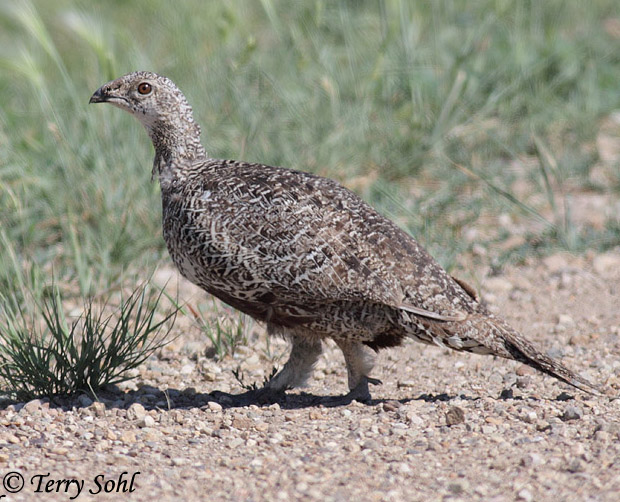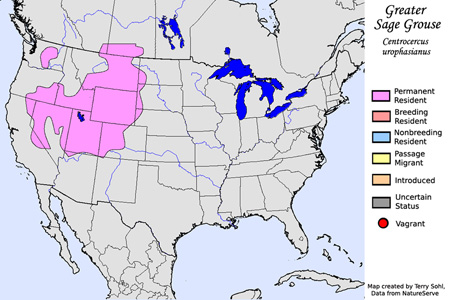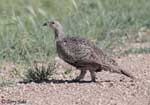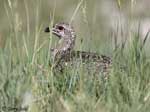Greater Sage Grouse
Centrocercus urophasianus
| Length: 22 to 28 inches | Wingspan: 28 to 38 inches | Seasonality: All Seasons |
| ID Keys: White breast ruff (male), black belly, mottled brownish-gray overall. | ||
 The largest of the North American Grouse, the Greater Sage Grouse and the very similar
Gunnison Sage
Grouse were just recently split into two separate species, when it was
discovered that Gunnison Sage Grouse (not found in South Dakota) were
genetically distinct and had different breeding displays and calls.
Greater Sage Grouse have spectacular spring mating displays on their leks
(traditional breeding grounds), with male birds struting and rapidly
inflating and deflating the large air sacs in their breast (see photo to the
right). Sage Grouse
are heavily dependent on sagebrush habitat, and quickly disappear from areas
where this habitat is converted to agricultural fields or grasslands for
grazing. A female is depicted in the photo on the right.
The largest of the North American Grouse, the Greater Sage Grouse and the very similar
Gunnison Sage
Grouse were just recently split into two separate species, when it was
discovered that Gunnison Sage Grouse (not found in South Dakota) were
genetically distinct and had different breeding displays and calls.
Greater Sage Grouse have spectacular spring mating displays on their leks
(traditional breeding grounds), with male birds struting and rapidly
inflating and deflating the large air sacs in their breast (see photo to the
right). Sage Grouse
are heavily dependent on sagebrush habitat, and quickly disappear from areas
where this habitat is converted to agricultural fields or grasslands for
grazing. A female is depicted in the photo on the right.
Habitat: Only found in habitats with sagebrush in the vicinity, including open plains, mountain valleys, mountainsides, and high mesas.
Diet: Relies very heavily on leaves and fresh shoots of sagebrush, especially during the fall and winter. Will eat other leaves, flowers, buds, and fresh shoots in other seasons, and also consumes some insects during summer months.
Nesting: May and June. The nest is a shallow scrape in the ground, lined with sparse bits of vegetation. It is usually placed under a sagebrush plant, or at the base of other vegetation. The female usually lays between 7 and 9 eggs, and she alone incubates them. After the eggs hatch, the young quickly leave the nest. They are tended to by the female, but find their own food.
Song: Courting males make loud popping sounds from inflated air sacs. When flushed, makes a cuk-cuk-cuk call.
Migration: Generally a permanent resident throughout its range, although birds at higher elevations will move to lower elevations in the winter.
Interactive eBird Map: Click here to access an interactive eBird map of Greater Sage Grouse sightings
Similar Species: Gunnison Sage Grouse, not found in South Dakota.
Conservation Status: Has disappeared from much of its former range. Destruction of sagebrush habitat in much of the west has taken a heavy toll on this species and others that depend on these unique habitats. Declines in population and range are continuing. The IUCN currently lists the Greater Sage Grouse as "Near Threatened".
Further Information: 1) Patuxent Bird Identification InfoCenter, Greater Sage Grouse
2) Audubon Guide - Greater Sage Grouse
3) WhatBird - Greater Sage Grouse
Photo Information: July 23rd, 2012 - Harding County, South Dakota - Terry Sohl
| Click on the map below for a higher-resolution view |
 |
| South Dakota Status: Uncommon permanent resident in select locations in the extreme western part of the state. |
Additional Greater Sage Grouse Photos
Click for a higher-resolution version of these photos


